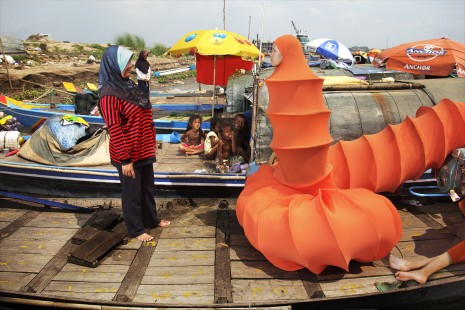There are some striking similarities between Anida Yoeu Ali and the subject of her latest exhibition, “The Buddhist Bug Project.” The bug’s face, for example, which is framed by an orange hijab, is Ms. Yoeu Ali’s. And like Ms. Yoeu Ali, the bug stands out in its surroundings. Or, rather, it doesn’t quite fit in.
Ms. Yoeu Ali is herself an amalgam of cultural and ethnic identifiers, each of which comes with its own—often conflicting—belief systems and stereotypes. And her exhibits are never straight-forward: The latest show, which opened on Friday, features photographs, video installations and a live performance from Ms. Yoeu Ali.
“The level of experimentation and trans-media is rooted in that culturally I am so mixed—Muslim-American, Khmer, Cham, Malaysian. There is not enough wiggle room for me as an artist to choose one medium,” she said.
As a semi-autobiographical representation of Ms. Yoeu Ali, the Buddhist Bug embodies many things at once. Its body is made of fabric that is the color of Buddhist monks’ robes but also forms the hijab that covers her head. The creature is often on the move, and while she seems to be perfectly comfortable in Phnom Penh, the people the Buddhist Bug encounters often don’t know what to make of her.
What is certain about Ms. Yoeu Ali’s latest creation is that it dominates the landscapes it inhabits. Much like elements from her last exhibition, “The Space Between Inside/Outside,” Ms. Yoeu Ali uses cloth, color and movement to transform everyday settings into something spectacular.
In one scene, which is presented through both photographs and a video, the Buddhist Bug, which is made of a 40 meters of orange lycra fabric wrapped around a series of hoops, winds down a two-story spiral staircase in the alley between low-rent apartment buildings that could be anywhere in Phnom Penh.
The video of the scene, shot by Adele Pham, begins with a close inspection of the Buddhist Bug, but then moves between the various people looking at the creature, and from the perspective of Buddhist Bug, we see the minute details of the scene: drying fish and old men chatting, bringing significance and depth to a scene that would otherwise seem perfectly ordinary.
And while the interactions between the Buddhist Bug and the Cambodians she meets sometimes verge on the absurd, there are moments of poignancy.
In one of the photographs in the exhibit, shot by Masahiro Sugano, the Buddhist Bug stands face-to-face with a woman from a Cham fishing community. One is wearing black pants, a striped shirt and a blue hijab while the other is wearing a giant orange caterpillar costume, but they share much more in common than their outfits imply.
Ms. Yoeu Ali, who describes herself as “a first generation Muslim Khmer woman born in Cambodia and raised in Chicago” was born in Battambang in 1974 and, after living for a brief time in the refugee camps along the Thai border, moved to the U.S. where she lived until two years ago, when she returned with Mr. Sugano, her husband and collaborator, and two children back to Cambodia.
Ms. Yoeu Ali also describes herself as a “political agitator,” and although she says she makes a point to remain apolitical in her work in Cambodia so as not to place any undue scrutiny on her assistants and collaborators, her characters often find their way to settings of conflict, dispute and loss.
In “The Space Between,” a lady in a sprawling red dress draped herself over the dilapidated buildings around the filled-in Boeng Kak lake, where residents have for years been protesting their eviction at the hands of a local business interest. The Buddhist Bug finds itself face to face with members of a poor fishing community that has been moved to make way the massive—and still unfinished—Sokha Hotel along the banks of the Tonle Sap river.
“She herself is a displaced creature,” said Ms. Yoeu Ali of the Buddhist Bug. “So it makes sense that she visits displaced communities.”
Ms. Yoeu Ali says she often finds her own frankness in conversation and directness to clash with what she calls a “passive-aggressive energy” in Southeast Asia. And the Buddhist Bug seems to have its own struggles fitting in here.
In a number of the exhibit’s photographs and videos, the people taking in Ms. Yoeu Ali’s performance are laughing, looking quizzically or staring in awe at the scene playing out in front of them. In other photographs, the Buddhist Bug is touring the city on a cyclo, but looks completely out of place with its expansive body scrunched into a seat fit for a small human.
And although Ms. Yoeu Ali says she has neither the intention nor the ability to shape the unfolding narrative of modern-day Cambodia, she and the Buddhist Bug are very much part of it.
“Contemporary Cambodia exists not only in Cambodia but also outside,” she said. Cambodians who have grown up outside the country “can bring our energy and ideas and not disrupt the narrative, but rather contribute to it,” she said.




